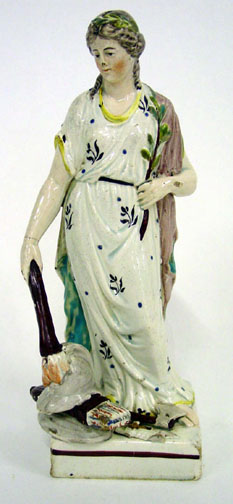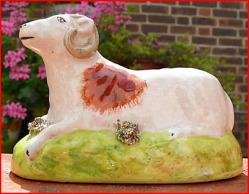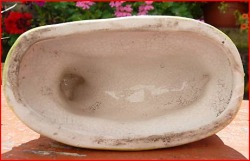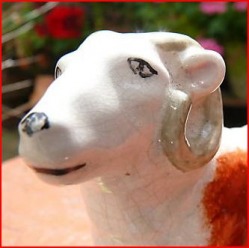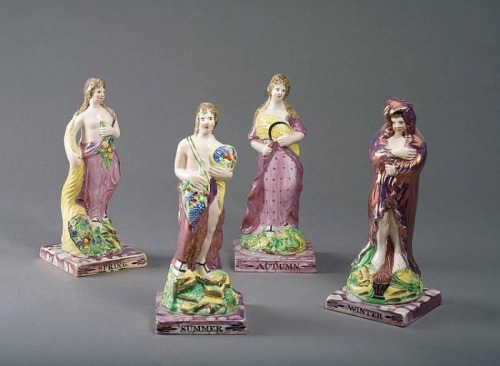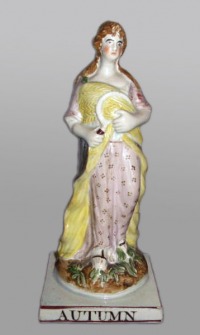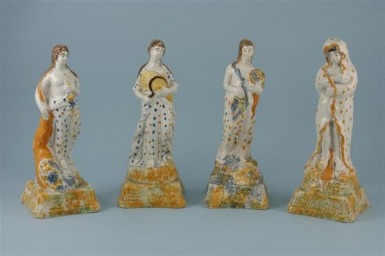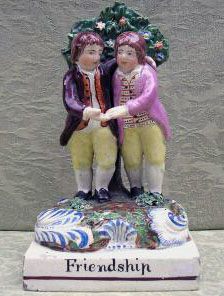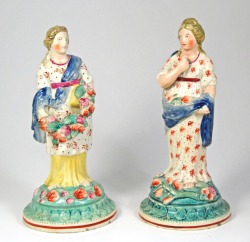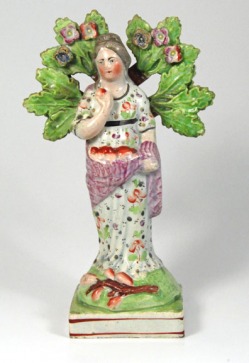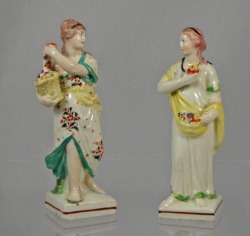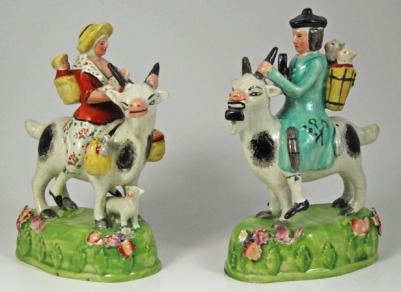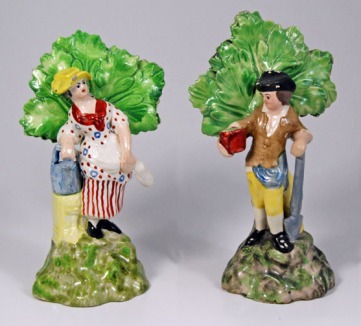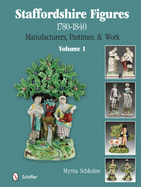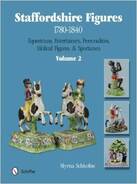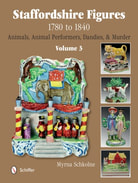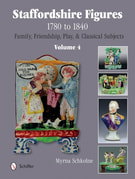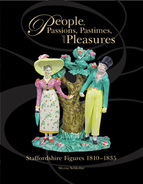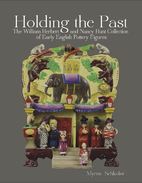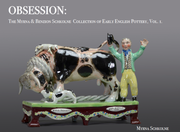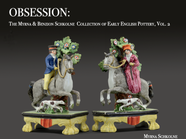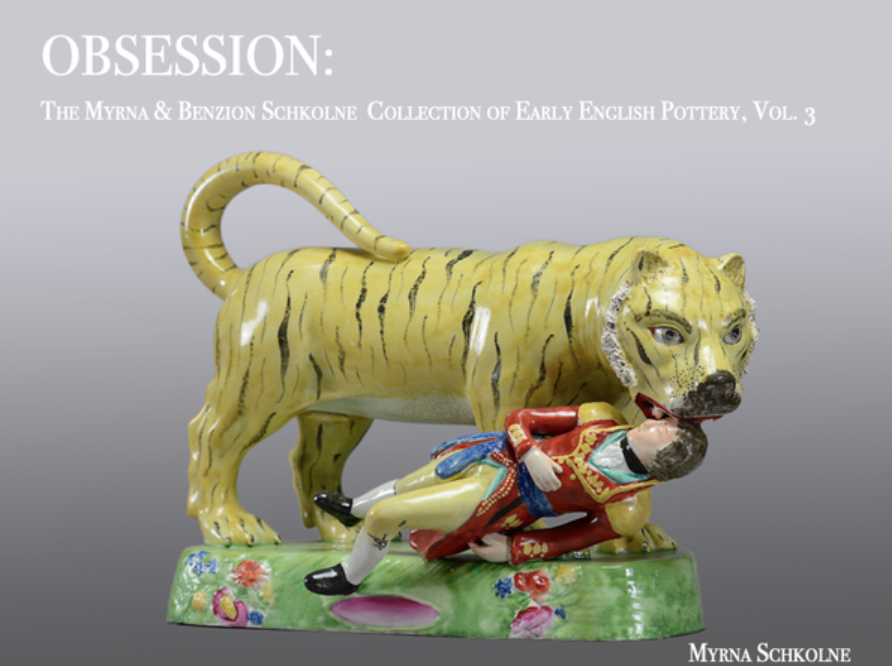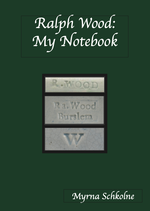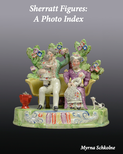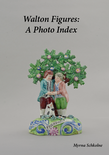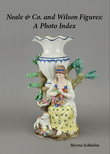These figures are about 9" tall. I know I should put measurements with each image, and I have no excuse for my laziness. If ever you really need to know, just ask.
|
This lovely lady represents Peace. More specifically, she symbolizes Peace burning the emblems of war. Note that the torch in her right hand is setting alight the accoutrements of war, including a helmet and spear. Lest you doubt that this figure is Peace, she carries a laurel branch in her left hand and wears a crown of laurels on her head. I rest my case! A particularly attractive Staffordshire figure is she not? I love her face, which is so very English. This is an unusual version of the figure. More commonly, Peace looks like a very matronly, heavy-hipped classical lady. The above figure is quite easy to find, whereas the first figure...well, I believe I know just one. Clearly some enterprising potter thought Peace needed an update.
These figures are about 9" tall. I know I should put measurements with each image, and I have no excuse for my laziness. If ever you really need to know, just ask.
0 Comments
Have just posted two items on Believe It? Both are described as early 19th century, which they are not, in my opinion. Several bloggers have emailed me--either to ask if the figures were right or to tell me they were not. I had already emailed the seller and was hoping for a positive outcome. Instead, no response. Anyway, there they are. The sheep leave me struck dumb. The dandies are a well known 20th century model. You can tell they are not early by the coloring (in particular the green on the base), the very poor modeling (look at those pinched pathetic faces), and the fact that the bocage is modeled as one structure--not built up from lots of separately made leaves. Another figure on eBay, item 150366752998, has me concerned and I have not written the seller. The little sheep is currently at $360! The piece was slip cast, not press molded. See the smooth interior contours, formed as the liquid slip settled. No fingers pressed clay into a mold here. Also, for a figure this size, the sheep might have been modeled independently of the base. This is not a MUST, but note this figure comprises just two mold parts--even the horns are integral to the mold. The little tufts of extruded clay on the base don't look like any I have seen before. And the sheep's face is so poorly painted.
A picture is worth a thousand words, but it does not replace a touch. Wish I could examine this to be more than 99% sure. And I wish I had written to the seller. Not enough time in a day to follow up on the dubious items on eBay. If you are in doubt, ask me. If you are certain tell the seller. And by all means report the item to eBay. Click REPORT ITEM, and then use the drop down menu to pick FRAUDULENT LISTING. If enough of us shout, we will be heard! Read the new Believe It? posting re the Kent tithe pig group. So common you can almost recognize it with your eyes closed, I hope.
My friend David Lindquist of Whitehall at the Villa Antiques, one of the finest antiques shops in the south, has started a blog on his website www.whitehallantiques.com. Look for BLOG in the top right hand corner of the site and learn how to tell the good from the bad when it comes to furniture. David is a past President of the National Association of Dealers in Antiques and has numerous important publications to his credit. He and his daughter Elizabeth have stock that is truly yummy and if you can't visit in person, watch for them at leading antiques shows across the country. I don't perceive myself as a lustre lover. Most of the pieces on the market get a bit heavy and Victorian for my taste--but I have always admired the Dixon & Austin ladies depicting the Four Seasons. Height around 9 inches. To find an odd one or two of these figures is possible, but to locate a true set is a daunting task. Assembling a set is almost impossible because, placed side by side, odd examples can differ markedly in titling and intensity of color. Anyway, this set has lived together always. No repair or restoration either. Their early, soft lustre glimmers deliciously--rich and smooth. Marked beneath: DIXON AUSTIN & CO. This mark was used between 1820 and 1826 by the Sunderland Pottery (also known as the Garrison Pottery because of its location next to the town barracks) on the mouth of the River Wear. John Baker in his Bible on lustre, Old English Lustre Pottery, describes this set of Seasons as 'the most desirable examples of Sunderland pink lustred wares'. Few complete sets are documented. However, it seems these molds were used beyond the Garrison potbank. Perhaps they were first used elsewhere. Who knows? Enamel examples occur (see Autumn below) but I have yet to see all four examples, let alone a set. Griselda Lewis, whom I admire greatly, used a set of Pratt ware Seasons in color on the inside cover (what do you call those pages?) of her latest edition of Pratt Ware. And Andrew Dando has a set of Pratt Seasons on his website, www.andrewdando.co.uk See below. (Photo courtesy Andrew Dando Antiques.) First time I recall one of these sets on the market. The Seasons seem to have been a particularly popular subject in the early 1800s. Probably the popularity of Thom's poems, titled The Seasons, made these figures appropriate decor for an aspirational upper middle class home. Many different sets were made--one day I shall try to document the number. It is never difficult to find an odd season. Finding a set is a true challenge. Assembling a set from varied examples usually leads to an obvious mismatch. So when you find a complete set you like, reach into your pocket.
I have a full set of Walton figures with bocages. Gorgeous things. You can see them in my book, People, Passions, Pastimes, and Pleasures: Staffordshire Figures 1810-1835. I first discovered these when photographing for my book. I made a point of never mixing my book with any commercial transaction, but as the collector and I became better friends I popped the question: Would he remember me IF he ever considered selling his Walton Seasons? He hesitated for a moment and then replied that he had no need of money, but there was another rare figure he badly wanted and he would trade if I could find the figure. The challenge was on! For six months I scoured the planet. Success at last! The trade was made across an ocean, and we are both so happy with the result. Several super additions to the stock of John Howard www.antiquepottery.co.uk. As always, John sets a really high standard. No need to pick through crud here! Two of the figures are featured in the Showcase on this site. Enjoy.
This pearlware Staffordshire figure titled Friendship sold on EBay a while ago, after being advertised thus: "The ornate scroll work at the front and sides of the grass is typical of Obadiah Sherratt." The sole basis for the attribution was the blue scroll work on the base.. What do you think? Was the attribution correct or wasn't it?
Well, the figure is definitely not necessarily by Obadiah Sherratt because there is no scientific basis for attributing anything to him. But in broader terms, the figure does not fall into that group of figures that we dub"Sherratt style" (see the postings for Obadiah Sherratt? in late May and early June.) Many pearlware figures made in the Staffordshire Potteries in the early decades of the nineteenth century were adorned with blue scroll work.....because it was pretty, of course! John Walton, who potted from around 1810-1830, used particularly lavish blue scrolls on some of his bases, and he marked many of his figures. But no-one had the monopoly on blue scrolls. Other, unknown potters used them too. Two further points:
Although this site focuses on pre-Victorian figures, the integrity of the antique pottery market as a whole concerns all of us. So read the tale of two Victorian figures just posted under the "Beware" tab and draw your own conclusions. Pity the auction house, Tooveys, that appears to have detected and disclosed much restoration was penalized by not selling the item. And I wish that all auction houses were as conscientious about condition reports.
I have just received a refund for an item I returned to an esteemed US auction house because of significant undisclosed restoration. The auction house was honorable and very nice about it, and a refund was no problem--but I was told that for what I paid I should have expected an issue! The problem is that for what I was prepared to pay, based on the condition report, I did not expect a problem. Again, Buyer Beware! Do you know the identities of these lovely ladies, portrayed as pearlware figures? They are Flora and Pomona, great favorites with 18th and early 19th century Staffordshire potters. The pair above are in the 'Sherratt' style. And last but not least, a tiny pair of Flora and Pomona. Collectors often overlook small figures on dealers' stands, as they seem lost among the larger wares. But these tiny treasures 'pop' among a collection in a home setting. I just love them. BTW, these were bought months apart from the same seller. She didn't realize they were a pair!
These Staffordshire figures are dubbed "the Welsh tailor and his wife." They are pearlware, in the 'Sherratt' style, made circa 1820. The models are after Derby figures, first made by the Derby factory in 1760 and copied from the Meissen figures that Kaendler and Eberlein modeled circa 1740.
The figures are supposedly inspired by a real incident. Count Heinrich von Bruhl (1700-17630) was Prime Minister of Saxony and Director of Meissen from 1735. A profligate dandy, he offered his tailor a reward of his choosing for meeting a deadline. The tailor chose to attend a court banquet. This request was considered ridiculous, so instead porcelain forms of the tailor and his wife were placed as table decorations on the count's banquet table. “Welsh” in the figure’s title results from incorrect translation of Meissen’s title of the figure “Ein Schneider welcher auf einem Ziegenbock reutet” (A Tailor who rides a goat…). So more correctly, these figures are "the Welch tailor and his wife." The Staffordshire Figure Association's annual meeting is a great shopping venue for collectors. Where else can you find over a dozen dealers offering just Staffordshire figures--not to mention the collectors who also may want to sell? At venues such as this, I am always on the lookout for unusual figures. And it is even more exciting if I manage to complete an unusual pair. The figure below represent such a 'match made in heaven.' I bought the lady gardener from Aurea Carter because the bocage was one I hadn't seen before. A while later, I found her mate. Treasure hunts like this make collecting an ongoing challenge...never-ending fun. Anyway, back to the meeting. The 2009 Staffordshire Figure Association meeting is being held in picturesque Lambertville, NJ from Sunday Sept 20 to Tues Sept 22. This illustrious group of enthusiastic members welcomes novices, serious collectors, and those with an interest in all things old. All that is required to join the SFA is annual dues of $35. The meeting itinerary is as below--copied from a letter sent to members recently. The SFA President is Elinor Penna. Please contact her at [email protected] for membership or meeting information. Hope to see you there!
|
Archives
February 2024
All material on this website is protected by copyright law. You may link to this site from your site, but please contact Myrna if you wish to reproduce any of this material elsewhere. |

